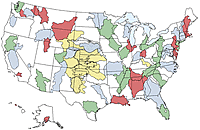National Water-Quality Assessment (NAWQA) Program

From 1991-2001, the NAWQA Program conducted interdisciplinary assessments, including water chemistry, hydrology, land use, stream habitat, and aquatic life, and established a baseline understanding of water-quality conditions in 51 of the Nation's river basins and aquifers, referred to as Study Units. Summary reports are available for the individual Study Units assessed from 1991-2001.
Geographic coverage: NAWQA Study-Units cover a variety of important hydrologic and ecological resources; critical sources of contaminants, including agricultural, urban, and natural sources; and a high percentage of population served by municipal water supply and irrigated agriculture. Study Unit boundaries frequently cross State boundaries and usually encompasses more than 10,000 square kilometers (about 3,900 square miles).
Rotational sampling: The Study-Unit design uses a rotational sampling scheme; therefore, sampling intensity varies year to year at the different sites. In general, about one-third of the Study Units are intensively investigated at any given time for 3-4 years, followed by low-intensity monitoring. Trends are assessed about every 10 years. During the first decade, 20 investigations began in 1991; 16 in 1994; and 15 in 1997.
Long-term: During the second decade (2001-2012), monitoring continues in 42 of the 51 Study Units completed in the first decade, following a rotational scheme of 14 investigations beginning in 2001, 2004, and 2007. Findings will help to establish trends at selected surface-water and ground-water sites that have been consistently monitored for more than a decade, and fill in gaps characterizing water-quality conditions.
Building blocks for regional and national assessments: Because each Study-Unit assessment adheres to a nationally consistent sampling and analytical methodology, water-quality conditions in a specific locality or watershed can be compared to those in other geographic regions. Collectively, the assessments advance an understanding of the quality of water across regions and the Nation. Information at different scales helps to bridge local, State, regional and national efforts to manage the Nation's water resources.